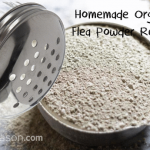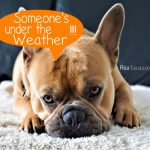Flea Questions and Answers
Common Flea Questions Answered
This page may contain affiliate links. Click here to read my affiliate policy.

Q and A about Fleas including:
- do Fleas bite humans
- do Fleas fly
- how to find Fleas on my dog
- when does Flea season start, and more.
Flea Questions and Answers:
Q: Can People Get Fleas?
A: Yes, Humans can get flea bites. Fleas will live in human hair, but you’ll find their bites on your arms and legs, around the waist, ankles, armpits, and in the bend of elbows and knees.
Q: Do Fleas Bite Humans?
A: The only species of Flea that lives on humans is known as Pulex irritans, and this Flea feeds on human blood. Along with humans, these Fleas also like to feast on dogs, cats, monkeys, birds, rodents, rats and bats. Needless to say – Fleas carry and can spread diseases such as Tapeworms, Murine typhus, and in certain parts of the world, Bubonic plague.
Q: How to Treat Human Flea Bites?
A: Do not use pet Flea killers on yourself because you’ll either get very sick, or they just won’t work. There are home remedies for human Flea bites you can try – if they don’t relieve the Flea bite area, then you should consult with a physician.
Wash Flea bites with an antiseptic soap to prevent infection. Follow with a cold compress or ice pack to reduce swelling. Apply a topical solution such as 0.5% or 1% hydrocortisone cream or calamine lotion. A natural option to these is to mix baking soda with a small amount of water until it forms a semi-think pasty consistency. You’ll have to apply the baking soda mixture to the Flea Bite area five to six times per day.
Do Not scratch your Flea bites because scratching can lead to an infection. If your flea bite areas worsen or if you notice a discharge oozing from the bites – contact a physician as soon as possible.
Natural Flea Killers For Humans
Here are a couple solutions you can use for at-home treatment of Human Fleas. Be sure to do follow-up treatment to kill any newly hatched Fleas or Flea eggs.
Tea Tree Oil
Mix one tablespoon of tea tree oil into a bottle of shampoo. Wash and shampoo your hair gently massaging the scalp are thoroughly for a good one to two minutes. Allow the mixture to sit in your hair for at least ten minutes. Do not get this shampoo/tea tree oil mixture into your eyes – if you do, rinse your eyes with clear cool water immediately. Rinse out the shampoo with warm water. Repeat these steps in eight to ten days to kill any newly hatched Fleas.
Rubbing Alcohol
Get your hair soaking wet in the shower. Pour one cup of rubbing alcohol into your hair and gently massage the rubbing alcohol throughout your hair. Rinse your hair with warm water to remove the alcohol. Repeat this wash three to four times, and you’ll be Flea free.
Q: Can Fleas Kill Humans?
A: It’s rare in this day and age for humans to die of Flea bites. Is it possible for humans to die from Flea bites? Yes.
A bacteria (yersinia pestis) spread by fleas killed 25 million people in14th century Europe. This was the ‘black plague’. Epidemics also occurred in Egypt, Africa, China, India and even the United States, before antibiotics were discovered and made available.
Today – plague occurs worldwide, and each year a few cases of Bubonic plague are recorded in the United States, mostly in the Southwest region. This disease is normally carried by wild rodents, and transmitted to the Fleas that bite them. Humans typically get the disease from the bites of infected Fleas. Pets can bring plague infected Fleas into the home where they live.
Fleas also transmit another disease by the name of Murine typhus, where only a few cases are reported annually within the United States.
Q: How to Find Fleas on Dogs?
A: If your dog has been scratching a lot and you suspect they have Fleas, go ahead and give your dog a bath. Watch for Fleas heading toward your dog’s head or crawling up your arm. The Fleas will try and escape the water.
Towel dry your dog and use a metal fine tooth comb, either a comb for Fleas or Lice. Part your dog’s hair and inspect for tiny brown specks or red patches of skin. Also check you dog’s tummy area, but don’t use the comb on the belly as it will scratch and irritate their skin in this area.
If you see any Fleas, pick them off and immediately put into a bowl of water that you’ve added ammonia or rubbing alcohol to.
FYI: Flea waste is digested blood. If you find any little brown spots in your dog’s hair or on their skin – place the brown spots on a wet paper towel. If the brown spots turn a pinkish-red – this is Flea waste and your dog needs a Flea bath.
Q: How Can I Tell if My Dog or Cat Has Fleas?
A: Your first alert is excessive scratching. If your cat or dog scratches more than normal, you can assume they most likely have Fleas.
First two ways I’d check for Fleas are:
1) Inspect for Fleas with giving your pet a bath. If you see anything crawling around or up your arm – then you know Fleas are present.
2) Lay your dog or cat on a white sheet or blanket, position them on their back (tummy upright). Rub their neck and back areas vigorously. What do you see? Tiny brown things that aren’t dirt? Probably dead Fleas. Little brownish-black squiggles? These are Flea poop. Tiny, tiny white colored ovals? These are Flea eggs. If you see any of these, then your pet most likely has Fleas.
If you find no evidence of Fleas at all, then it’s possible your pet may have an allergy, but 9 out of 10 times – excessive scratching indicates Fleas are present.
Q: Can Fleas Kill Dogs?
A: A severe or prolonged Flea infestation can kill a dog. A multitude of Fleas have the potential to cause anemia so severe a dog will die without a blood transfusion.
Fleas feed on blood. The dog is a blood bank for the Flea. Fleas also carry diseases such as tapeworm and heartworm, both of which can be fatal to a dog.
Q: Can Fleas Kill Cats?
A: Yes, a Flea infestation will cause anemia and the cat will need a blood transfusion at a pet hospital or by a veterinarian. Fleas carry diseases that if transmitted can be fatal. Fleas on kittens can quickly dehydrate their tiny bodies and cause anemia, which can also be fatal.
Q: How to Take Fleas Off a Dog?
A: It’s extremely difficult to ‘catch a live Flea’. Several effective methods to take Fleas off a dog are:
– Bath the dog and pick out the Fleas you see trying to escape the water.
– Meticulously inspect the stomach area and coat of your dog for live Fleas.
Q: How to Kill Fleas on Dogs?
A: Use Diatomaceous Earth (food grade) and lightly sprinkle and work gently into the pet’s coat. Use Dawn dish soap and bathe your dog, also use a metal flea comb dipped in a water and Dawn dish soap solution to remove fleas from your dogs coat. Give your dog a Capstar tablet.
You must Flea-treat your entire house and yard area to keep Fleas away, or your
dog will continue to get Fleas. If you aren’t going to treat your yard – the best Flea prevention is monthly Frontline Plus Drops or similar topical Flea treatment.
Q: How to Kill Fleas Naturally on Dogs?
A: My favorite natural Flea Killer is Diatomaceous Earth (food grade) powder. Other organic Flea killers my friends use include Tea Tree Oil, Rosemary Oil, Sweet Orange Oil, Eucalyptus Oil, Citronella Oil. A natural plant based and effective Flea spray you can buy is the Vet’s Best Flea and Tick Home Spray for Cats and the Vet’s Best Flea and Tick Home Spray for Dogs.
For a homemade Flea treatment use any of the above oils and mix 3 parts water to one part oil. Put in a spray bottle and lightly spray your dog’s coat. Let air dry.
Make a homemade Herbal Flea Dip by taking 2 cups fresh rosemary leaves and add to 2 cups of water. Bring water to boil and continue to gently boil for 30 minutes. Strain the water mixture (throw away the rosemary leaves) and add this solution to a gallon of warm water. Use this solution as a rinse to pour over your dog, until saturated. Don’t rise off with water but leave in coat and allow to air dry. (Do not use Essential Oils on cats or kittens)
Q: How to Rid House of Fleas?
A: Wash everything in your house your dog or cat touches in hot water. Place in dryer on a high-heat dry setting. Vacuum your house thoroughly several times. Don’t forget to vacuum and treat any places your pet spends time, such as your car, the pet carrier, garage and/or basement.
Outside your house, remove the vacuum bag and place in another bag and and dispose of in the outside garbage. If your vacuum is bagless, take the vacuum outside, empty the vacuum container into a bag, tie the top and place in your outside garbage can. Don’t empty your vacuum in the house, because live Fleas can escape back into your home.
Spray corners of house and carpet with a natural Flea Spray or lightly distribute food grade Diatomaceous Earth. Treat your pet with a monthly Flea treatment such as Frontline or Advantage to keep Fleas away.
Q: What Kills Fleas?
A: There are many natural solutions that kills Fleas such as Bragg Vinegar, certain essential oils, and Dawn dish soap. Homemade solutions and natural solutions will kill Fleas but aren’t very good at preventing Fleas from returning.
Ingredients found in monthly Flea treatments such as Frontline Plus kill active Fleas plus the eggs, and systematically keeps your pet safe from Flea re-infestation for 30 days.
Q: How to Get Rid of Dog Fleas?
A: – Give your dog a Flea Bath.
– Give your dog a Capstar tablet.
– To prevent Fleas returning to your dog, apply Frontline or Advantage drops
Q: How to Get Rid of Fleas on Cats?
A: Getting rid of Fleas on Cats is the same as getting rid of Fleas on dogs. Using a metal comb dipped in a solution of Dawn dish soap and water, comb your cat’s neck, back and legs. Dip the comb in the soapy solution over and over to release any Fleas in the comb. Give your cat a Capstar.
Give your cat a Flea bath, then apply a topical Flea treatment such as Frontline or Advantage. Thoroughly de-Flea your house and yard to prevent a Flea re-infestation.
Q: Do Fleas Fly?
A: Fleas do not fly. Fleas have no wings. Fleas have 3 pairs of legs. Fleas jump. Fleas have super strong rear legs, making the Flea one of the best jumpers of all known animals (relative to body size). Fleas are artful and speedy jumpers – so fast you probably won’t see them jump from one area to another.
Q: What Do Fleas Look Like?
A: Adult Fleas are usually about 1/8″ long (bigger after sucking blood) and are dark in color. Flea bodies are hard and shiny, and shaped as a teardrop.
Flea Eggs are very small and shaped like an oval and tend to be whitish in color.
Flea Larvae are a bit bigger than adult Fleas and about 1/4″ and resemble maggots in appearance. Their pale-color worm-like bodies are covered in bristles. (yuck!)
Q: What Are Flea Beetles?
A: Flea Beetles are found outside and don’t attach themselves to dogs or cats. Some Flea beetle species are beneficial, feeding on weeds and similar nuisance plants. Other Flea beetle varieties are a major pain in the butt to home vegetable gardens and commercial agricultural crops. They will occasionally damage flowers, shrubs and even trees.
Adult Flea beetles are typically small with often shiny bodies and with large rear legs that allow them to jump like a flea when disturbed. Food grade Diatomaceous Earth is commonly used as an effective repellent, applied as a dry powder to plants and crops.
Q: What Are Sand Fleas?
A: Sand Fleas are found at the beach. They feed on decaying things such as seaweed or creatures washed up onto the beach. Sand Fleas are most active early morning and late at night.
Sand Fleas can burrow themselves under your skin. Sand Flea bites can cause itching, welts and lesions. Sand Fleas are known to spread infections and diseases just like mosquitoes.
Do not scratch a Sand Flea bite no matter how much it itches. Soak with warm water and apply Aloe Gel or make a paste of water and baking soda, apply to the bite area.
Take some Aleve or Tylenol. To remove a Sand Flea under the skin, soak the area several times with rubbing alcohol. Consult a physician if basic treatments have no effect on the bites, or if a bite starts to show signs of infection (extreme redness and pain or fever).
Sand Fleas will attach themselves to a Dog and you should treat the same as for regular Fleas. If you see any welts on your dog’s skin – use rubbing alcohol. If any redness progressively gets worse, the dog will need professional medical attention. Take your dog to the Vet as soon as possible.
Q: When Does Flea Season Start?
A: Fleas are more prevalent in warm temperatures. Don’t assume that because the Spring and Summer seasons have passed, you don’t need to worry about Fleas. In the United States Flea Season lasts most of the calendar year.
Fleas thrive and breed in temperatures 60 degrees and above. As long as adult Fleas have a feeding ground (dogs, cats, humans) they can breed. When Flea larvae have sufficient humidity, at least 50% of them will hatch.
Inside homes where the climate temperatures are controlled, Fleas live and breed all year long unless every trace of Fleas, Flea eggs and Flea larvae are eliminated.
Fleas are found in just about every location of the world and in warm climates there is no end to Flea Season. Warm, wet climates have Fleas every day, all year long.
Q: When is Flea Season Over?
A: Flea Season fluctuates from country to country and climate to climate. All USA states bordering the Pacific Ocean and almost all of the USA Southern states have no seasonal interruption from Fleas. Inside homes where the temperature is above 60 degrees – it’s always Flea Season.
Q: Which USA States Have the Most Fleas?
A: In the USA, the states with the most Fleas are the Southern and Southwestern states, as well as Hawaii.
Q: What Type of Weather Brings Out Fleas?
A: Warm and humid weather, and climates will bring out Fleas.
Q: Do Floor Steam Cleaners Kill Fleas?
A: Absolutely Yes! Home Steam Cleaner (use for fleas) will kill Fleas and Dust Mites – plus will sanitize the area. The high temperature heat kills Fleas, Flea eggs, and Flea larva. Using a steam cleaner will get rid of Fleas from beds, and hard surface floors without the use of harsh chemicals. First vacuum, then run your steam cleaner over floors, carpets and beds.

















Connect: